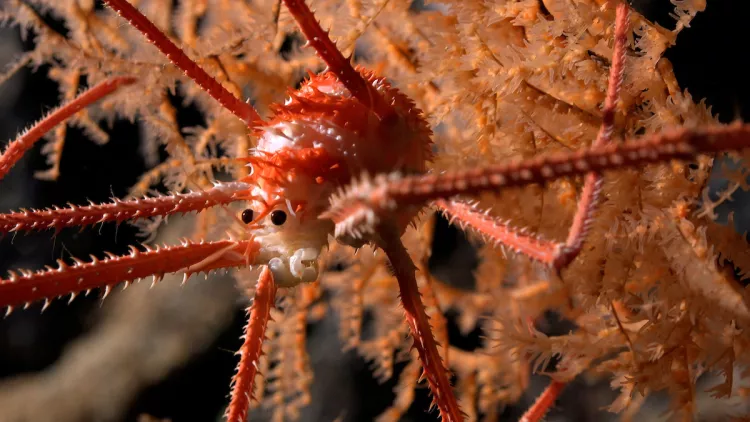Over 100 Potentially New Species Discovered in Chilean Seamounts Expedition
In a groundbreaking expedition led by Dr. Javier Sellanes from the Universidad Católica del Norte, an international team of scientists have stumbled upon a treasure trove of over 100 potentially undiscovered species residing in seamounts off the coast of Chile.
- Video file
The Schmidt Ocean Institute-sponsored venture delved into the depths of the Nazca and Salas y Gómez Ridge, both within and outside Chile’s jurisdiction, revealing a rich tapestry of marine life, including deep-sea corals, glass sponges, sea urchins, amphipods, squat lobsters, and numerous other species that could be novel to science.

A squat lobster documented in coral at a depth of 669 meters on Seamount JF2.
The focal point of the exploration was the Salas y Gómez Ridge, an extensive underwater mountain chain spanning 2,900 kilometers, encompassing more than 200 seamounts from offshore Chile to the renowned Rapa Nui, or Easter Island. A significant portion of this ridge lies beyond national jurisdiction. The researchers also scrutinized two of Chile’s marine protected areas – the Juan Fernandez and Nazca-Desventuradas marine parks.
Equipped with an advanced underwater robot capable of descending to depths of 4,500 meters, scientists gathered crucial data from ten seamounts. This information aims to bolster Chile's initiatives towards establishing an international high-seas marine protected area. Each seamount proved to host unique ecosystems, including delicate deep-sea coral reefs and sponge gardens, many of which are considered vulnerable.
The extensive mapping efforts by the team covered 52,777 square kilometers of seafloor, leading to the identification of four seamounts within Chilean waters. Of particular note was the exploration of the tallest mountain, reaching 3,530 meters, which was officially mapped and unofficially christened "Solito" by the research team.
Dr. Javier Sellanes expressed his excitement, stating, “We far exceeded our hopes on this expedition. You always expect to find new species in these remote and poorly explored areas, but the amount we found, especially for some groups like sponges, is mind-blowing.” He emphasized that the thriving ecosystems discovered underscore the effectiveness of marine parks in safeguarding delicate habitats.
A follow-up expedition is already in the pipeline, set to embark on the research vessel Falkor on February 24. This second leg of exploration along the Salas y Gomez Ridge will feature underwater dives livestreamed on the Schmidt Ocean Institute’s YouTube channel, providing a unique opportunity to witness scientific exploration in areas deeper than 600 meters for the first time. Schmidt Ocean Institute plans to continue its operations in the Southeast Pacific, exploring the waters off Peru and Chile throughout 2024.
Schmidt Ocean Institute Executive Director, Dr. Jyotika Virmani, highlighted the significance of the discoveries, stating, “Full species identification can take many years, and Dr. Sellanas and his team have an incredible number of samples from this amazingly beautiful and little-known biodiversity hotspot.” She also emphasized the institute's commitment to the Nippon Foundation – Nekton Ocean Census Program, which aims to discover 100,000 new marine species over the next decade, with the newly found species becoming integral to this ambitious initiative.


























